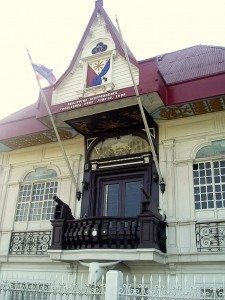Philippine News
A look back in history: The Aguinaldo Shrine in Kawit, Cavite
MANILA — As the Philippines celebrates its 116th year of independence on June 12, 2014, it is only fitting that we look back on where it all began — the Aguinaldo Shrine (then mansion) in Kawit, Cavite, where the Filipino tri-color was first unfurled, symbolizing a nation’s birth and freedom against colonial oppressors.
The mansion was constructed in 1845, out of wood and nipa. It was latter enlarged and modernized in 1849, a reflection perhaps of the uplifting of the social and financial status of the Aguinaldo family.
It was in this house where Emilio F. Aguinaldo was born to Carlos Aguinaldo and Trinidad Famy on March 22, 1869.
Emilio Aguinaldo was the seventh child of the couple, whom historians described as “well-to-do” as patriarch Carlos was the community’s appointed “gobernadorcillo” (municipal governor) in the Spanish colonial administration.
Emilio Aguinaldo later joined the secret society Katipunan which was founded by Andres Bonifacio, among others, on July 7, 1892.
When the revolution against Spain broke out on August 23, 1896, he became the leader of the Katipuneros in Cavite and immediately rose to the rank of general.
On June 12, 1898, Gen. Emilio Aguinaldo led the declaration of Philippine independence from Spanish colonial rule from the window of the grand hall of the mansion in Kawit.
The Act of the Declaration of Philippine Independence was read to the people of the country by its author, Ambrosio Rianzares Bautista.
The Declaration of Independence was ratified by the Malolos Congress on Sept. 21, 1898.
During the independence celebration, the Philippine flag designed by General Aguinaldo was formally unfurled from the front window of the house.
It was first flown during the Battle of Alapan in Imus two weeks prior, on May 28, 1898. This event is now celebrated as National Flag Day each year.
The Philippine national anthem was also first played on the grounds by the marching band of San Francisco de Malabon (now General Trias, Cavite) but as an instrumental music. Its lyrics were not written till 1899 by José Palma.
The mansion underwent its third enlargement and modernization from 1919 to 1921.
This was done by Aguinaldo as part of his efforts to transform it as a monument to flag and country.
He constructed an elaborate “Independence balcony,” which is now used by top Philippine officials during independence day celebrations.
Aguinaldo donated the mansion to the Philippine government on June 12, 1963, “to perpetuate the spirit of the Philippine Revolution of 1896 that put an end to Spanish colonization of the country.”
Aguinaldo died on Feb. 6, 1964, at the age of 94 at the Veterans Memorial Hospital in Quezon City.
The same year, the government declared the mansion as a National Shrine on June 18 through Republic Act No. 4039 signed by President Diosdado Macapagal.






















